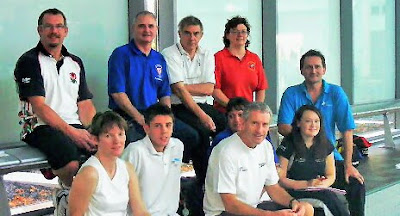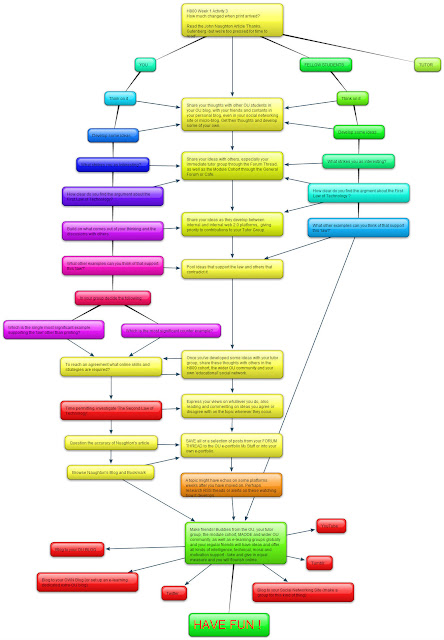New Software
Things I was starting to get my head around in 2010:
- Skype (a phone call for free)
- Delicious (don't get it, yet ... or need it?)
- Outlook (Never used it 'til last week not being a PC person)
- Google Docs (Up there and loading docs. Hear good things from all)
- Compendium (Created a map for an e-tivity based on my H807 ECA. Populating this to share content with a producer).
- Zoho (signed in but not sure)
- Mahara (But Google does it for free and has seamless interplay with all your other favourite Google tools)
- Pebblepad (Mixed reviews)
- Adobe Share (Been using Adobe products forever so this should get my attention)
- Internet Explorer (new to this Mac user!)
- Dropbox (I've always been a box person)
Where I stand in 2012:
- Skype (use often to friends globally, notably for a job interview with Getty Images, interviewing Dr about Qstream and on an iPad passing my brother and my nephews around a room of cousins between the UK and South Africa at Christmas)
- Delicious (Still struggle, not least as I have more than one account and because I don't see the need to bookmark anything as to Google is quicker and with cookies enabled takes me into my choices)
- Outlook (formerly trained at the OU on Outlook - training on a 2010 version while we had a 2011 in our office. Still hate it having been raised on all things Mac. Outlook has the look, feel and functionality of Microsoft DOS c 1992)
- Google Docs (Use as a store to aggregate content, sometimes to share, wiki-like with fellow OU students who are more ofay with the technology than I am)
- Compendium (Can't stand it - prefer a variety of free iPad Apps, including SimpleMinds, Bubl.us and several others).
- Zoho (signed in and gave up)
- Mahara (signed in a gave up)
- Pebblepad (signed in and gave up - initially making do with the OU's MyStuff, which has been discontinued. Find it easier to aggregate content, while I'm an OU Student in my OU Blog, then cut and paste into one or more WordPress blogs - I had 16 at the last count)
- Adobe Share (Don't have the budgets, may be of interest once back in a commercial office)
- Internet Explorer (Never. Over the period have slowly migrated away from Firefox, like family, use Google Chrome almost exclusively)
- Dropbox (Not really)
- PicasaWeb - download for all images from camera, iPhone and iPad. Fix then post to some 50 albums, some with over 1000 images (the Picasa limit), pay for extra space. Uncertain or lack confidence though in degree of privacy, especially if screengrabs and other images are automatically uploaded to Google + images (same PicasaWeb account in a different format)
Where I stood in 2010 compared to 2012:
Old Software
- Word (Yes, but far less often. I write far more often on the iPad using the AI Writer APP, emailing this to a PC to edit, or uploading into a blog to edit there)
-
Filemaker Pro (No longer. I ran it on Macs and iBooks from its inception but others don't prefering of all things the ghastly Excel). Have Bento, baby FileMaker, on the iPad.
- AOL (still with AOL, but prefer Gmail and still thinking about changing supplier to BT or Sky)
- Power Structure (Didn't upgrade, my iBook died and the software is on an rescued harddrive though I doubt it will work with a new operating system)
- Final Draft (An execellent script writing tool though created for linear output)
- Adobe Photoshop (Haven't upgraded, making do with Picasa)
- Dreamweaver (haven't been near it, I never was a programmer type anyway, though cut my teeth in this in 2000)
- Excell (A very reluctant user - just cannot see how this is used by some to create posters, or run a database that required large quantities of content in a cell. Filemaker Pro is better)
Blogs
- Diaryland (Quite the thing in 1999). Locked forever. Up forever. Sometimes cut and paste. Always amusing to read posts on developments in web-based learning c. 1999
- LiveJournal (Preferred by 2002). A stepping stone out of Diaryland.
- WordPress (Expert) Over a dozen blogs, most notably Mymindbursts, though no longer a diary or journal, but a niche journal largely about e-learning, with subject intersts including creative writing, philosophy, tertiary education, history (First War), online and distance education, theories of education. Also blogs on swim coaching and teaching, on the Machine Gun Corps, on the trials and tribulations of a househusband (from old diaries and blogs), on various fiction themes - but also a number of Books of Condolences, in 2011 for colleagues, but very sadly in 2012 for my mother too.
- EduBlogs (No more)
- Blogger (No longer)
- OuBlog (Extensively for all Masters in Open and Distance Education modules, now on my fifth and final module. Daily reflection, updates, aggregating resources, screen clips, diagrams, images, snips from forums, links to other blogs, tagging to assemble content for assignment, re-blog with re-writes to external blogs. Use it like an e-portfolio with CVs and job descriptions here too.)
- Blipfoto (A picture a day for four or five months - until I have my iPhone to my son. I make do with an iPad and prefer a cheap phone to have kicking around in my pocket or bag ... and to avoid being online when out on the South Downs walking the dog!)
Social Networking
- Facebook (Love hate. Great to be in touch with immediate family and trusted friends only. Got some groups going with boys I knew age 8-13 at boarding prep school. Got out of hand when a relation fell very ill and died as to the appropriateness of sharing our concerns and grief online. Inclined to disengage - do so only to find I am still there?)
- MySpace (Never, though I am there)
- Friends Reunited (Never since they started to charge, or since they came back)
- Linkedin (extensive, professional use with several hundred contacts and activity in many groups. Feed blog content into Linkedin automatically, tailor some content for specific groups, particularly relating to e-learning for corporates and tertiary education)
- Twitter (extensive, professional use. Did use TweetReach and various other tools. URLs shortened from WordPress, will use Bitl.y)
Other
- Flickr (Used to use extensively - migrated all content to Picasa as Flickr tried to socialise the space and I found my pictures being offered for sale!)
- Kodak Easyshare (Rescued 500 of 700 uploaded photos and migrated to Picasa before Kodak closed)
- YouTube (Should be making extensive use of YouTube. Starting to digitise 40 hours of Oxford Undergraduate life 1982-1984. With permissions will migrate clips to the web in due course.)
- Picasa (my favourite now, the teenagers are on Instagram and Tumnblr)
- Ancestry.com (Covered every conceivable ancestor as far back as is possible online. Could make use of the 2011 census to track down a great aunt but not inclined to fork out anymore or to deal with spurious requests from people so off the map in terms of the family tree it is verging on trainspotting.)
- Genes Reunited (as above. Not been near it) Of minor interest at a family funeral to figure out who were the common ancestors - both gentleman born in the 1870s it turned out!
Browsers
- Firefox (very rarely, probably in erro)
- AOL (winding up here for the last 18 months, should have got out long ago.)
- GoogleChrome (Almost exclusively)
- Internet Explorer (avoided at all costs)
What's new?
For the last 18 months extensive use of an iPad and associated Apps, so much so that it is the replacement laptop and even covers as a mobile phone as people know to email me.
Trying to do my final MAODE module on the iPad.
Proving remarkably easy to do so.
Very versatile, especially where resources can be downloaded as PDFs, even to read in Kindle version. Read from the Kindle, note take on the iPad and post online.
Books. We no longer buy them. Is a garage full of wonderful hardbacks worth anything? Glad I never bothered to put up shelves.
Magazines and newspapers. All redundant. Only kept the Guardian on Saturday to have something to line the guinea-pig hutch, when they went so did the newspaper!
TV. Rarely ever watched live. Prefer BBC iPlayer. Exception being the Olympics and Paralympics.
Pen and paper. I do. An A5 notebook and pen. Though prefer to type up notes as I go along.
Twitter Share. Reading an eBook and sharing a line or two with a note directly into Twitter. This aggregates content in an editable format and alerts 'followers' to a good read - usually on learning, education, e-learning, also on social media, story writing and the First World War. Sometimes some great out of copyright literature.



